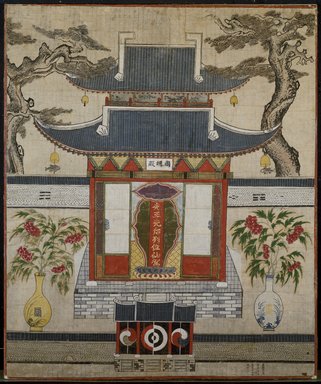
Medium: Ink and color on paper
Geograhical Locations:
Dates:June 1811
Dimensions: 67 5/16 × 56 5/8 in. (171 × 143.8 cm) frame: 70 × 59 1/4 × 2 3/4 in. (177.8 × 150.5 × 7 cm)
Collections:
Accession Number: 86.25
Image: 86.25_SL3.jpg,
Catalogue Description: From "Korean Art Collection in the Brooklyn Museum" catalogue: Image of a small shrine situated on a platform on a terrace. Paintings of shrines (gammo yeoje do) often replaced actual ancestral shrines in the late Joseon dynasty. This example is particularly interesting because it is dedicated to the king and the queen of the state instead of family ancestors. According to the inscription on the painting, the painting was completed in the sixth lunar month of 1811 at the Hall of East Fragrance, a place that most likely belonged to a local government office. It is an important historical document that proves that shrine paintings were not only in demand by commoners but also by public offices. Mounted in Western style (i.e. no longer in hanging scroll format). From Catalogue Card: Spirit shrine paintings were specifically intended for use in Joseon dynasty homes; an ancestral shrine was an integral part of every Korean house; ancestor worship was the primary duty of every Korean family, who were morally obliged to worship their ancestors for at least three generations back. A wealthy household maintained a separate room, or even a separate building as an ancestral shrine. The room was equipped with special furniture and utensils for the rituals of ancestor worship; altar tables and offering stands as well as a small but very high chair that served as a throne for the ancestor’s spirit. "Kam Mo Yo Je Do" means "Shrine Where the Ancestors Come When Worshipped." The space between the open doors of the tile roofed shrine in the painting was left blank. On the anniversary of an ancestor’s death, a slip of paper inscribed with his posthumous name was pasted temporarily on the blank space. This painting commemorates royal ancestors; the table is inscribed with the spirit names of a former king and queen. Dated at the lower right: June 16th year of the Chia-ch'ing reign (1796-1820). It is usual for the dates on Korean paintings to refer to Chinese Reigns rather than Korean ones.